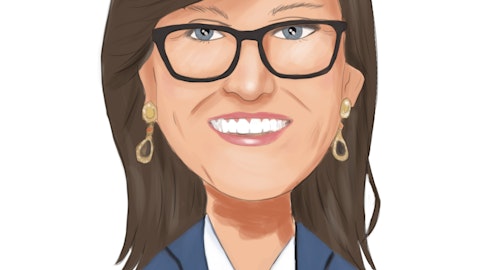Equally as frequently, we’re going in with our suite of chronic care solutions where they don’t have one in place. And so that is an evolutionary sale. It certainly doesn’t happen all at once. So I wouldn’t expect us to all of a sudden go from 16% to 30% or 40% penetration. We are working on solutions like our bundling structures in order to accelerate the penetration. But right now, we guide based on what we know and what our existing trends are. So as we see breakthroughs to the degree that we see breakthroughs in our ability to more rapidly penetrate our book of business, we’ll update our guidance. But our guidance right now is based on the progress that we’re making and our outlook based on what we know, not based on any breakthroughs that we haven’t yet identified.
Operator: The next question comes from the line of George Hill with Deutsche Bank. Please proceed.
George Hill: Yes, good evening, Jason and Mala. I’ll try to be efficient with my questions here. And I guess my first one, Mala, is on the cost savings program, which is you guys are targeting 50 basis points to 100 basis points of margin expansion per year, but the cost savings programs alone should give you almost 150 basis points margin expansion in 2024 and over $325 million. So I guess I’d ask you what are the offsets in the underlying business through eroding where the cost savings programs don’t give you more margin expansion?
Mala Murthy: Yes. Thanks, George. So if you just think about 2024 as we have said, we’ve talked about our guidance of $350 million to $390 million in adjusted EBITDA. That includes the $35 million of cost savings that we have talked about. The reality is, if you think about the way the margins we expect in 2024, the margins to play out, we are seeing some modest pressure on our gross margin line from higher clinical costs, and that’s primarily associated with the expected ramping up in Primary360 volumes. We added about $30 million in Primary360 revenue over the course of 2023, and that was a very, very significant increase in revenue for P360 and we expect visit volume from those members to continue to ramp up through 2024.
And so that ramp will create some modest pressure on gross margins this year relative to 2023. Now that variance, that delta is being offset by leverage from operating expenses and in particular, as we said in our prepared remarks, technology and development and G&A. So that’s sort of the way the sort of the margin structure is feathering through the whole P&L.
Operator: Thank you. The next question comes from the line of Sean Dodge with RBC Capital Markets. Please proceed.
Sean Dodge: Yes. Thanks. Last quarter, along with the operational review, you also talked about undertaking a portfolio assessment. Is there any update you can share on that? Are there any portfolio actions in the savings you laid out from the efficiency program? Or would those be incremental? And then maybe if you could give us some sense of what a portfolio assessment may involve? Are there particular geographies, markets, books of businesses that just don’t make sense to be in anymore?
Jason Gorevic: Yes. So I’ll start by saying there are no significant portfolio changes contemplated in our guidance anything that we would do would be incremental to that. When we talk about doing a portfolio assessment, it really is looking across the business for two dimensions. One, the profitability and growth outlook for the various customer, channels and segments, products within our portfolio, geographies, et cetera. And then second is, where do we place investments. So where do we get the greatest yield on investing our dollars, especially in technology and development and advertising and marketing. So I think that’s what’s involved in it. If we have any significant actions, obviously, we’ll announce it. A lot of it, quite frankly, is fine-tuning.
Sometimes it’s fine-tuning pricing. Sometimes it’s fine-tuning go-to-market strategy. Sometimes it’s fine-tuning service model and service intensity to make sure that we are optimizing our resource allocation versus the profitability of a given customer segment or products.
Mala Murthy: Yes, I would say — I would add, Sean, look, as we look at our both top line growth as well as bottom line profitability, we have set expectations for the next few years, we’ll continue to look at the various pieces of our business, how they contribute to both top line growth as well as bottom line profitability. And so that’s a review that is ongoing. We will continue to look at that. And as Jason said, we are judicious in the investments we make. We have talked about getting leverage from technology and development and G&A. That said, we are also going to continue to invest robustly in the business, whether it be in terms of product, data, data science. And so in order for us to fuel those investments and the investment capacity, the responsible thing for us to do is to just continue to look at all parts of our business in terms of how they are contributing to both top line as well as bottom line.
Operator: Thank you. The next question comes from the line of Ryan Daniels with William Blair. Please proceed.
Ryan Daniels: Thanks for taking my question and thanks for all the detailed commentary thus far. Maybe a little bit of a different line of questioning. I’m just curious in regards to capital deployment. You clearly have a lot of cash. You mentioned maybe a repo, but more curious about the overall capital structure and how you view it. I know you have some of the [indiscernible] converts of about $550 million that will be concurrent in June and then a bigger convert a couple of years after that. So how are you thinking about potential refi or use of cash to pay that down over the coming quarters? Thanks.
Mala Murthy: Yes. Thanks for that question. Listen, as I step back and take a look at our capital structure, we are — we have the flexibility with the $1.8 billion cash that we have on our balance sheet and the fact that we generated strong free cash flow last year. We expect to continue to generate strong free cash flow this year. So that will certainly strengthen our balance sheet even more. If I think about the uses of cash, I would say the way I would prioritize it is, as we said, first, what are the interesting M&A opportunities that are out there that we could use our balance sheet for. Obviously, as always, those M&A opportunities need to meet the criteria that we set for ourselves, right? Whether they make strategic sense for us or whether they are financially attractive.
But I would expect to use the strength of our balance sheet towards the right M&A opportunities. And then I would use our cash to pay down to retire the debt specifically, you mentioned the [indiscernible] convert, which is due in the middle of 2025. I would look to pay that convert down. We still have some time and flexibility for the $1 billion convert that is maturing in 2027. And then last is, as we said, to the extent that we have even more flexibility on the balance sheet, opportunistically, strategically think about share buybacks. Share buybacks in general and to think about over the longer term to offset the potential dilution from employee stock grants. So I would think about it in those — sort of in those different ways.
Operator: Thank you. The next question comes from the line of Daniel Grosslight with Citi. Please proceed.
Daniel Grosslight: I want to go back to the BetterHelp marketing yield here. I was wondering if you could provide a little more detail on why those marketing yields remain depressed? Are consumers being a little more discerning? Are you seeing more competition from other DTC vendors? Is there another big vendor out there that’s spending like you saw 2022. Any additional detail there would be very helpful.
Jason Gorevic: Yes. So it’s — the answer to the second part of the question is we don’t see a significant competitor driving up the rates. We do see a lot of advertisers in general going after a similar population. So I wouldn’t say that it’s a single competitor as opposed to the overall traffic in the ad space, so to speak. And then maybe the last thing I’ll say is that, we do see it certainly more as we spend more, right? So as we increase our ad spend, we’re constantly looking at the marginal return on the — on each incremental dollar. And so, we work hard to make sure that each incremental dollar is productive for us. And to the degree that we see the curve get to an inflection where we run out of room on where we can spend that money productively then we pull back rather than chasing growth at the expense of profitability. So I think those are the major contributors to it.
Operator: Thank you. There are no additional questions left at this time. That concludes today’s conference call. Thank you. You may now disconnect your lines.





